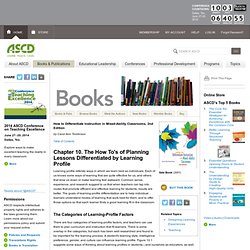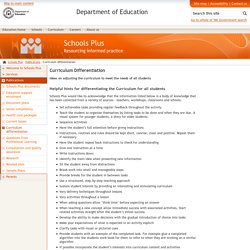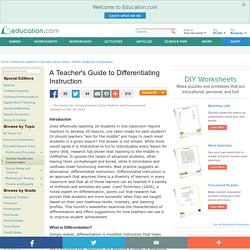

Differentiated Instruction Strategy Raft. The How To's of Planning Lessons Differentiated by Learning Profile. Figure 10.1.

Focus on Learning Profile Learning-Style Preferences Learning style refers to environmental or personal factors. Some students may learn best when they can move around, others need to sit still. Some students enjoy a room with lots to look at, color, things to touch and try out. Intelligence Preferences Intelligence preference refers to the sorts of brain-based predispositions we all have for learning.
Culture-Influenced Preferences Culture affects how we learn, as well. The goal of the teacher is, therefore, not to suggest that individuals from a particular culture ought to learn in a particular way, but rather to come to understand the great range of learning preferences that will exist in any group of people and to create a classroom flexible enough to invite individuals to work in ways they find most productive. Gender-Based Preferences Gender also influences how we learn.
Combined Preferences Some Guidelines for Learning-Profile Differentiation Figure 10.2. Entry Points. Daretodifferentiate.wikispaces.com/file/view/A_Treasure_Chest_Differentiation_Strategies.pdf. Presentations/ASCD_LowPrep.pdf. Shepparton High School Student Intranet. Methods of Differentiation in the Classroom. It’s a term that every teacher has heard during their training: differentiation.

Differentiation is defined by the Training and Development Agency for Schools as ‘the process by which differences between learners are accommodated so that all students in a group have the best possible chance of learning’. In recent decades it has come to be considered a key skill for any teacher, especially those of mixed-ability classes. But what does it really mean? What is meant by ‘differences between learners’? In a large class, differences between students may on the face of it seem too numerous to be quantified, but differentiation works on 3 key aspects which can be summed up as follows: Readiness to learn Learning needs Interest These differences may sound rather broad, but by applying effective methods of differentiation, it is possible to cater for quite wide variations between learners.
Task Grouping Resources Pace Outcome Dialogue and support Assessment. Curriculum differentiation - Schools Plus - The Department of Education. Ideas on adjusting the curriculum to meet the needs of all students Schools Plus would like to acknowledge that the information listed below is a body of knowledge that has been collected from a variety of sources - teachers, workshops, classrooms and schools.

Set achievable tasks providing regular feedback throughout the activity Teach the student to organize themselves by listing tasks to be done and when they are due. A visual system for younger students, a diary for older students. Sequence activities Have the student’s full attention before giving instructions Instructions, routines and rules should be kept short, concise, clear and positive. Differentiated programming. Students are individuals who learn at different rates and in different ways.

These individual differences may influence how students respond to instruction and how they demonstrate what they know, understand and can do. Individual differences may include: cognitive abilities, including students’ current level of understanding and ability in relation to a particular topic or skillprior learning experienceslearning styles and preferencesmotivation and engagement with learninginterests and talents. Through differentiated planning and programming, teachers can consider students’ varying abilities, learning styles, interests and needs. What is differentiation? Differentiation is a targeted process that involves forward planning, programming and instruction. Differentiated programming: Differentiated programming provides students with opportunities to: The diversity of learners The K–10 syllabuses are inclusive of the learning needs of all students.
How can teachers differentiate? A Teacher's Guide to Differentiating Instruction. Introduction Does effectively teaching 30 students in one classroom require teachers to develop 30 lessons, one tailor-made for each student?

Or should teachers “aim for the middle” and hope to reach most students in a given lesson? The answer is not simple. While most would agree it is impractical to try to individualize every lesson for every child, research has shown that teaching to the middle is ineffective. Education.alberta.ca/apps/aisi/literature/pdfs/Final_Differentiated_Instruction.pdf. Harvard Education Publishing Group - Home. Last year, when Sherryl Hauser, a third-year math teacher, had to plan a project to develop her teaching, it was an easy choice: differentiated instruction.

“One of the reasons I picked differentiating is that I kept trying it and it kept failing,” she says. It wasn’t as if she didn’t understand the concept. Hauser had coauthored an article, “Constructing Complexity for Differentiated Learning,” in the August 2009 issue of Mathematics Teaching in the Middle School. But in going from preservice grad student to full-time teacher at Sage Park Middle School in Windsor, Conn., Hauser saw a gap between theory and practice. Suddenly, “tiering”—or varying the difficulty of work for students based on readiness—had a twist: Kids didn’t like it when a classmate’s paper looked a lot different or had more problems on it.
This method is best embodied in the work of Carol Ann Tomlinson, whose books, videos, and DVD have been embraced by many school districts and professional developers.
Language Features Common Core Toolkit.pdf.